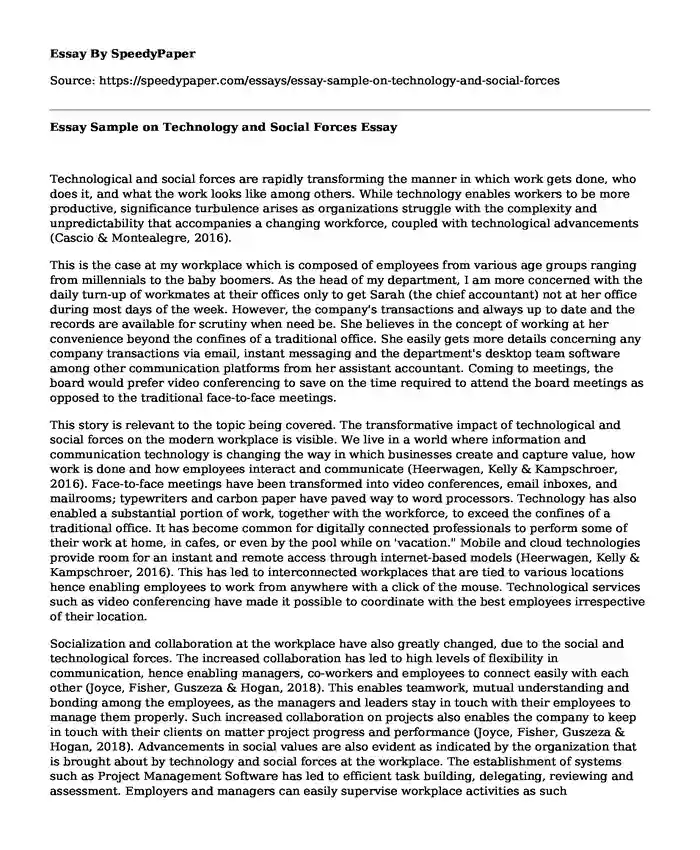
| Type of paper: | Course work |
| Categories: | Technology |
| Pages: | 3 |
| Wordcount: | 649 words |
Technological and social forces are rapidly transforming the manner in which work gets done, who does it, and what the work looks like among others. While technology enables workers to be more productive, significance turbulence arises as organizations struggle with the complexity and unpredictability that accompanies a changing workforce, coupled with technological advancements (Cascio & Montealegre, 2016).
This is the case at my workplace which is composed of employees from various age groups ranging from millennials to the baby boomers. As the head of my department, I am more concerned with the daily turn-up of workmates at their offices only to get Sarah (the chief accountant) not at her office during most days of the week. However, the company's transactions and always up to date and the records are available for scrutiny when need be. She believes in the concept of working at her convenience beyond the confines of a traditional office. She easily gets more details concerning any company transactions via email, instant messaging and the department's desktop team software among other communication platforms from her assistant accountant. Coming to meetings, the board would prefer video conferencing to save on the time required to attend the board meetings as opposed to the traditional face-to-face meetings.
This story is relevant to the topic being covered. The transformative impact of technological and social forces on the modern workplace is visible. We live in a world where information and communication technology is changing the way in which businesses create and capture value, how work is done and how employees interact and communicate (Heerwagen, Kelly & Kampschroer, 2016). Face-to-face meetings have been transformed into video conferences, email inboxes, and mailrooms; typewriters and carbon paper have paved way to word processors. Technology has also enabled a substantial portion of work, together with the workforce, to exceed the confines of a traditional office. It has become common for digitally connected professionals to perform some of their work at home, in cafes, or even by the pool while on 'vacation." Mobile and cloud technologies provide room for an instant and remote access through internet-based models (Heerwagen, Kelly & Kampschroer, 2016). This has led to interconnected workplaces that are tied to various locations hence enabling employees to work from anywhere with a click of the mouse. Technological services such as video conferencing have made it possible to coordinate with the best employees irrespective of their location.
Socialization and collaboration at the workplace have also greatly changed, due to the social and technological forces. The increased collaboration has led to high levels of flexibility in communication, hence enabling managers, co-workers and employees to connect easily with each other (Joyce, Fisher, Guszeza & Hogan, 2018). This enables teamwork, mutual understanding and bonding among the employees, as the managers and leaders stay in touch with their employees to manage them properly. Such increased collaboration on projects also enables the company to keep in touch with their clients on matter project progress and performance (Joyce, Fisher, Guszeza & Hogan, 2018). Advancements in social values are also evident as indicated by the organization that is brought about by technology and social forces at the workplace. The establishment of systems such as Project Management Software has led to efficient task building, delegating, reviewing and assessment. Employers and managers can easily supervise workplace activities as such advancements fix the accountability, responsibility, timely delivery and efficiency of tasks that are assigned to employees.
References
Cascio, W. and Monteleagre, R. (2016). How technology is changing work and organizations. Researchgate.net. Retrieved from https://www.researchgate.net/publication/299400943_How_Technology_Is_Changing_Work_and_Organizations
Heerwagen, J., Kelly, K. and Kampschroer, K. (2016). The Changing Nature of Organizations, Work, and Workplace | WBDG - Whole Building Design Guide. Wbdg.org. Retrieved from https://www.wbdg.org/resources/changing-nature-organizations-work-and-workplace
Joyce, C., Fisher, J., Guszeza, J. and Hogan, S. (2018). Positive technology. Deloitte Insights. Retrieved from https://www2.deloitte.com/us/en/insights/focus/behavioral-economics/negative-impact-technology-business.html
Cite this page
Essay Sample on Technology and Social Forces. (2023, Mar 29). Retrieved from https://speedypaper.net/essays/essay-sample-on-technology-and-social-forces
Request Removal
If you are the original author of this essay and no longer wish to have it published on the SpeedyPaper website, please click below to request its removal:
- Undergraduate Learning Profile in a Free Essay
- Free Essay on Gender Roles in an American Culture
- Free Essay Answering How The Crucible Is an Allegory for McCarthyism
- Essay Example about Change Management Models
- Essay Sample about Political and Social Change During the Early Meiji
- Earth from Space
- Essay Sample on Theoretical Approaches Used to Describe the Environmental Policy
Popular categories




